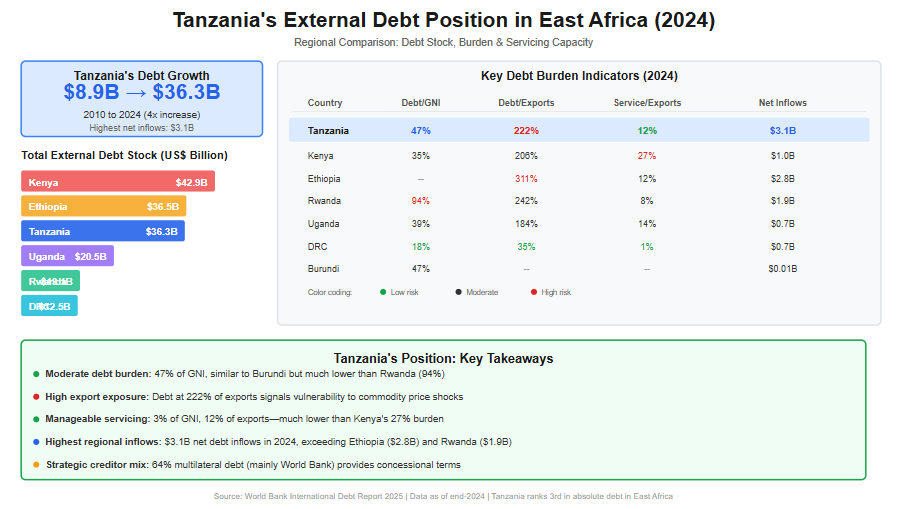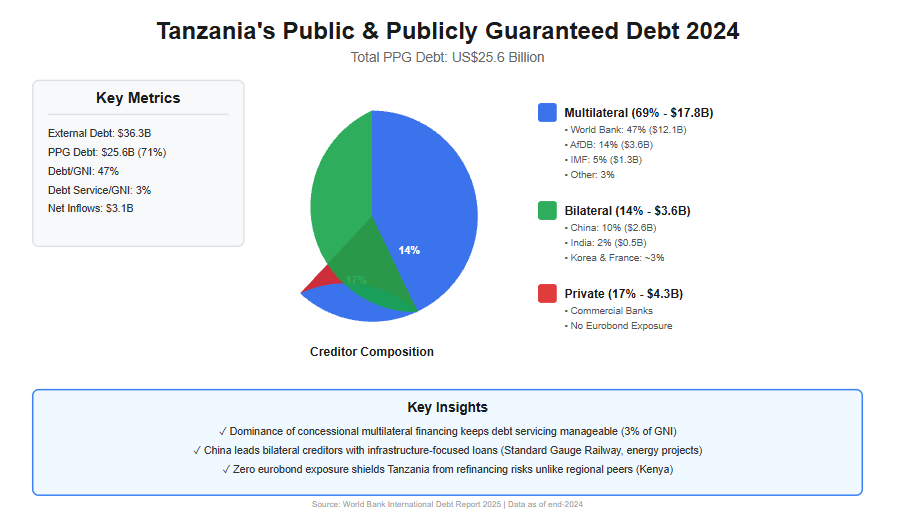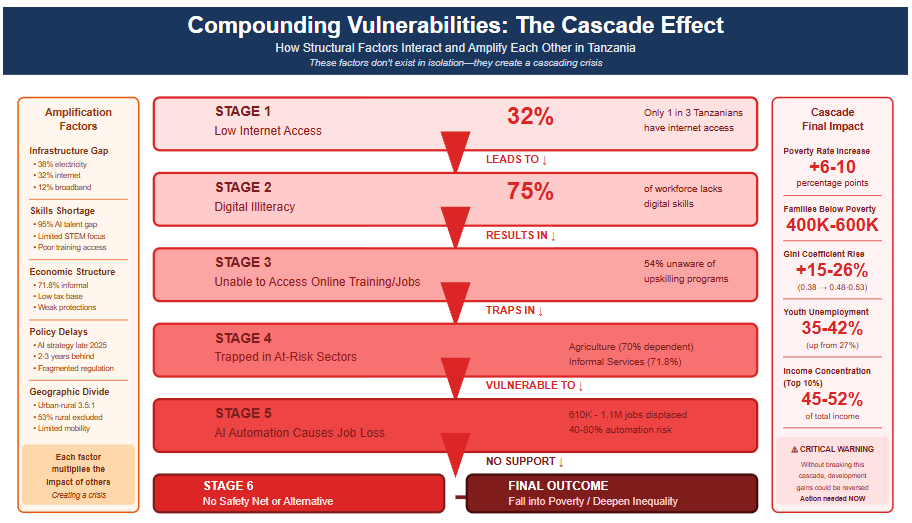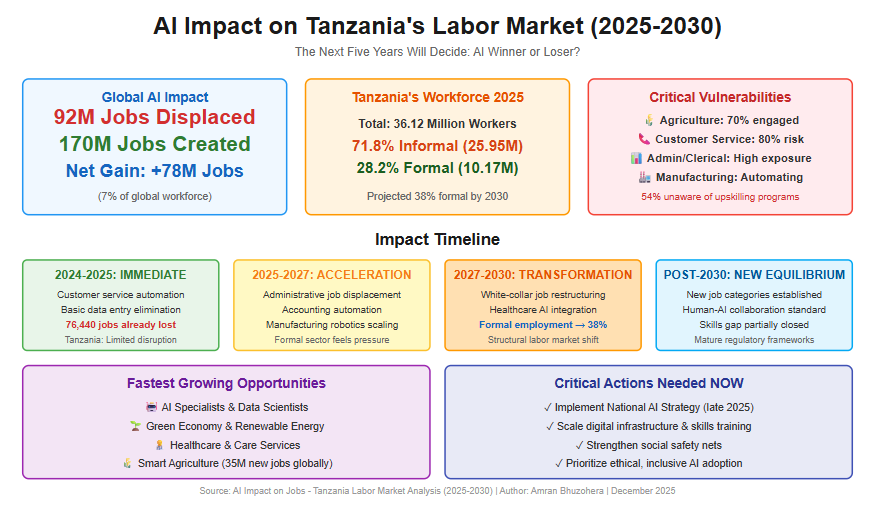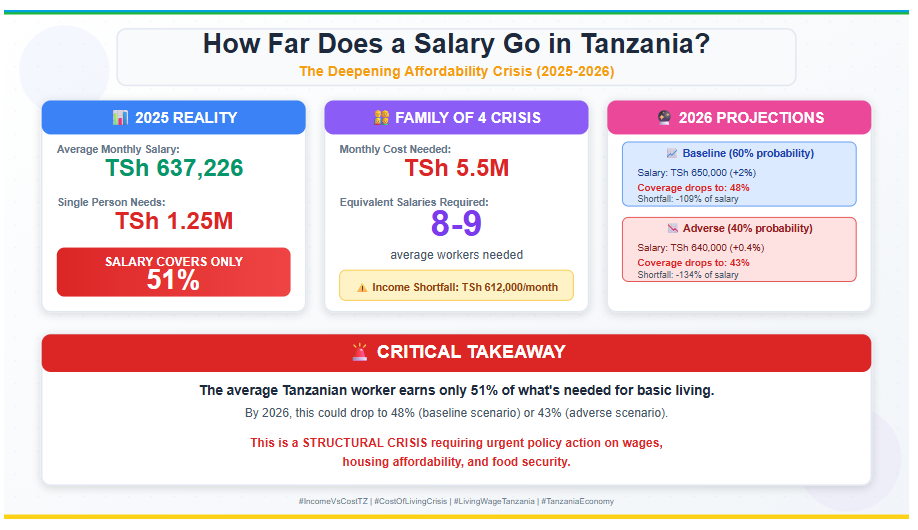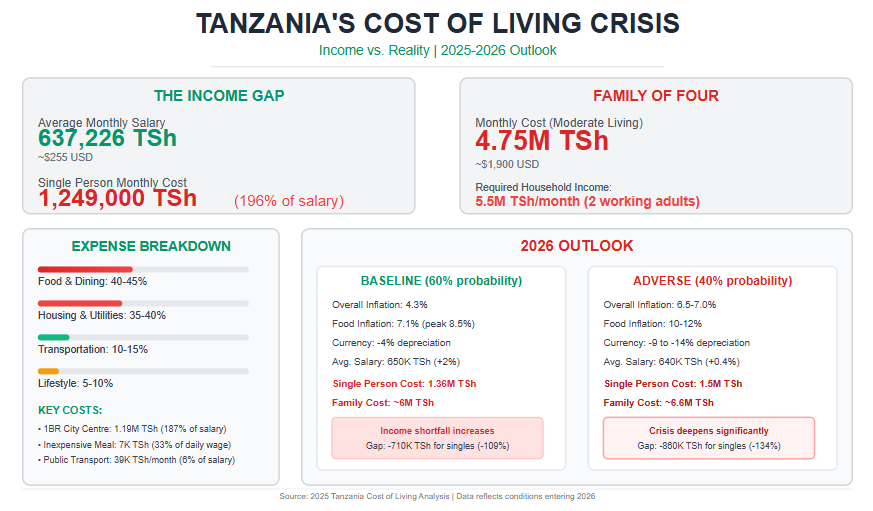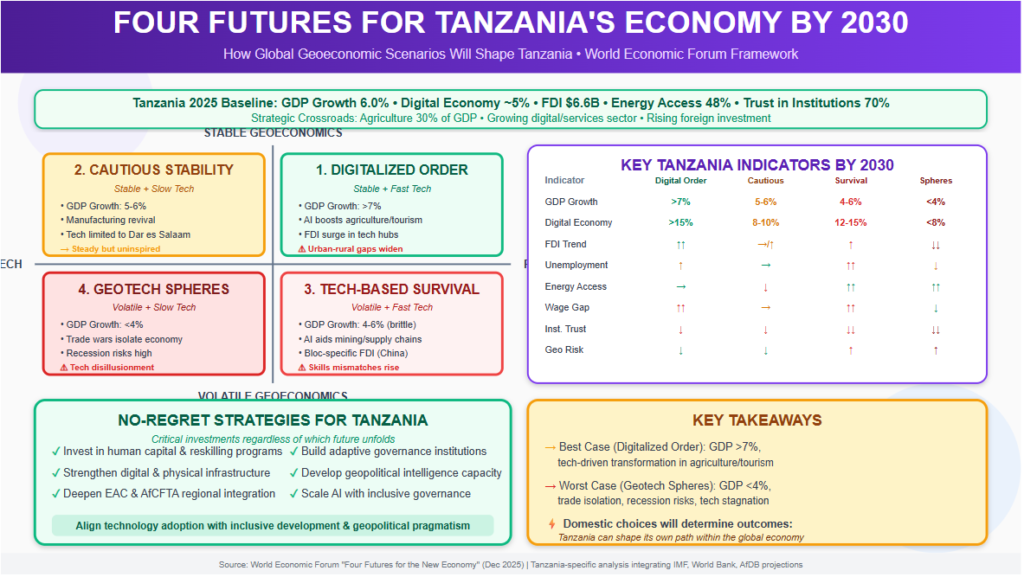Tanzania is facing a deepening economic paradox while employment remains the primary source of income for the majority of citizens, formal work is increasingly failing to provide a livable standard of living. Recent data from 2024/2025 show that the average Tanzanian worker earns between TZS 513,261 and 637,226 per month, yet the minimum monthly cost of basic living for a single person (excluding rent) is TZS 1,152,096, and rises to TZS 1.5–1.8 million when rent is included. This means that even before taxation, the average worker earns 53% less than what is required to meet basic living expenses, exposing a structural gap between wages and the real cost of survival.
This gap is further widened by Tanzania’s labour tax system, Employees are subject to mandatory PAYE (0–30%) and a 10% NSSF contribution, which together reduce take-home pay by 11–30% depending on income level. For an average worker earning TZS 637,226, total monthly deductions amount to TZS 97,623 (15.3%), leaving a net income of TZS 539,603. At this level, the affordability deficit increases from 53% before tax to over 62% after tax, meaning formal employment actively deepens financial strain rather than alleviating it.
At the lower end of the income spectrum, the situation is more severe. A worker earning TZS 400,000 per month takes home only TZS 353,700 after taxes, while basic living costs for a single individual remain close to TZS 960,000–1,152,096. This results in a monthly shortfall exceeding TZS 600,000, equivalent to 63–66% of essential needs being unaffordable. In practical terms, such workers would need to earn nearly three times their current net salary to meet basic consumption requirements.
Rising living costs intensify this crisis. Although headline inflation averaged 3.3% in mid-2025, food inflation surged to 7.6%, and housing, water, and electricity costs rose by 7.2%, disproportionately affecting low- and middle-income households. Food alone accounts for 38.5% of household expenditure, meaning inflation erodes purchasing power fastest where households spend most. When labour taxes are combined with food inflation, the data show a 23% reduction in real purchasing power for essential goods for the average worker between 2024 and 2025.
The burden does not stop at direct salary deductions. Employers face an additional 14.5–14.6% in labour-related charges (employer NSSF, SDL, and WCF), costs that are often passed on to consumers through higher prices or absorbed through suppressed wage growth. As a result, workers effectively pay twice—first through reduced take-home pay and again through higher prices for goods and services. Compared to regional peers, Tanzania’s 20% combined social security contribution is the highest in East Africa, making it the least competitive in terms of labour costs and further constraining job creation and wage growth.
Taken together, the evidence suggests that Tanzania’s labour tax system, when applied to already insufficient wages and compounded by rising living costs, is not merely reducing disposable income—it is systematically pushing workers below the cost of living. The outcome is a growing population of formally employed yet economically insecure workers, unable to afford adequate food, housing, healthcare, education, or savings. This raises a critical policy question: can a labour tax structure that erodes basic economic wellbeing remain sustainable without undermining productivity, social stability, and long-term economic growth?
Is Urgent Labour Tax Reform the Only Path to Protect Workers and Economic Stability?
The evidence presented in this analysis leads to an unavoidable conclusion: Tanzania’s labour tax system, when applied to wages that are already below the cost of living and compounded by rising prices, is pushing large segments of the working population into economic distress rather than financial security. Formal employment, which should serve as a pathway out of poverty, is instead becoming a mechanism that entrenches vulnerability and deepens inequality.
The burden falls most heavily on specific groups. Low-income workers earning below TZS 500,000 per month face an average affordability deficit of 66%, meaning that nearly two-thirds of their basic needs remain unmet even after working full-time. For these workers, there is effectively no viable path to survival within the formal economy. Women workers experience a compounded disadvantage, earning on average 10.5% less than men while facing identical labour tax rates and living costs, resulting in a deeper post-tax affordability gap. Single parents, relying on a single income to support entire households, are structurally unable to meet food, housing, education, and healthcare needs under current wage and tax conditions.
Geographic and demographic disparities further reinforce this crisis. Rural workers, despite facing lower absolute living costs, still experience an estimated 62% post-tax deficit due to significantly lower wages, leaving them trapped in subsistence-level living. Young families are among the most affected: with net incomes far below the cost of raising children, securing housing, and saving for the future, many are forced to delay parenthood, accumulate debt, or abandon long-term economic planning altogether. These outcomes are not isolated hardships but systemic failures embedded in the interaction between wages, taxes, and living costs.
At the national level, the system is increasingly economically unsustainable. The average worker in Tanzania cannot meet basic needs even when fully employed, as 15–30% of already inadequate income is removed through labour taxes and mandatory social contributions. Meanwhile, food inflation of 7.6% continues to erode purchasing power faster than wage growth, particularly for low- and middle-income households where food accounts for the largest share of expenditure. Rather than narrowing, the affordability gap is widening as the country approaches 2026, signaling a deepening crisis rather than a temporary imbalance.
As a result, workers are being pushed into a self-reinforcing cycle of debt, informal employment, and declining living standards. When formal work fails to provide economic dignity, workers rationally exit the tax net, undermining the very revenue base the labour tax system is designed to support. Without immediate and deliberate intervention, Tanzania faces serious macroeconomic and social risks: rising poverty and inequality, accelerated brain drain as skilled workers seek opportunities abroad, heightened social tension driven by economic frustration, a shrinking formal tax base, and the emergence of generational poverty as families lose the capacity to invest in education and human capital.
The data is clear and consistent across income groups, regions, and household types. Tanzania’s labour tax system is misaligned with the economic reality of its workforce. Urgent reform is required—not only to protect workers’ basic wellbeing, but to preserve productivity, social stability, and long-term economic growth. Without aligning labour taxation, wages, and the true cost of living, the question posed by this analysis answers itself: yes, the current system is pushing workers below the cost of living—and the consequences of inaction will be far more costly than reform. Read More of This Topic: How Far Does a Salary Really Go in Tanzania Today?
1. Current Economic Reality: Income vs. Cost of Living Gap
1.1 Income Landscape
| Income Category | Monthly Amount (TZS) | Annual Amount (TZS) | USD Equivalent (Monthly) |
| Average Salary (2025) | 513,261 - 637,226 | 6,159,132 - 7,646,712 | $190 - $235 |
| Median Salary | 1,150,000 | 13,800,000 | $425 |
| Minimum Wage (Private Sector) | 150,000 | 1,800,000 | $55 |
| Public Sector Minimum | 500,000 | 6,000,000 | $185 |
| Low-Skilled Workers | 419,500 | 5,034,000 | $155 |
| High-Skilled Workers | 884,100 | 10,609,200 | $327 |
1.2 Cost of Living Requirements
| Household Type | Monthly Cost (TZS) | Annual Cost (TZS) | Affordability Gap |
| Single Person (excluding rent) | 1,152,096 | 13,825,152 | -614,870 (deficit 53%) |
| Single Person (with rent) | 1,500,000 - 1,800,000 | 18,000,000 - 21,600,000 | -962,774 (deficit 64%) |
| Family of Four (excluding rent) | 4,100,000 | 49,200,000 | -3,562,774 (deficit 87%) |
| Family of Four (with rent in Dar es Salaam) | 5,000,000 - 6,000,000 | 60,000,000 - 72,000,000 | -4,462,774 (deficit 89%) |
Critical Finding: The average worker earning TZS 637,226/month faces a deficit of 53% even before paying rent, meaning they earn less than half of what they need for basic living expenses.
2. Labour Tax Burden Analysis
2.1 Tax Deductions from Gross Salary
Using examples from the original tax table, here's what happens to actual take-home pay:
Example 1: Low-Income Worker (TZS 400,000/month)
| Component | Amount (TZS) | Percentage |
| Gross Salary | 400,000 | 100% |
| Less: NSSF Employee (10%) | (40,000) | -10% |
| Taxable Income | 360,000 | 90% |
| Less: PAYE Tax | (6,300) | -1.6% |
| NET TAKE-HOME | 353,700 | 88.4% |
| Total Labour Tax Burden | 46,300 | 11.6% |
Impact: This worker loses TZS 46,300 (11.6%) to labour taxes, reducing already insufficient income.
Example 2: Average Worker (TZS 637,226/month)
| Component | Amount (TZS) | Percentage |
| Gross Salary | 637,226 | 100% |
| Less: NSSF Employee (10%) | (63,723) | -10% |
| Taxable Income | 573,503 | 90% |
| Less: PAYE Tax | (33,900) | -5.3% |
| NET TAKE-HOME | 539,603 | 84.7% |
| Total Labour Tax Burden | 97,623 | 15.3% |
Impact: The average worker loses TZS 97,623 (15.3%) monthly, widening the affordability gap from 53% to 62%.
Example 3: Middle-Income Worker (TZS 1,200,000/month)
| Component | Amount (TZS) | Percentage |
| Gross Salary | 1,200,000 | 100% |
| Less: NSSF Employee (10%) | (120,000) | -10% |
| Taxable Income | 1,080,000 | 90% |
| Less: PAYE Tax | (152,000) | -12.7% |
| NET TAKE-HOME | 928,000 | 77.3% |
| Total Labour Tax Burden | 272,000 | 22.7% |
Impact: This worker, already struggling to meet family costs of TZS 4.1M, loses TZS 272,000 (22.7%) monthly to labour taxes.
Example 4: Upper-Income Worker (TZS 2,500,000/month)
| Component | Amount (TZS) | Percentage |
| Gross Salary | 2,500,000 | 100% |
| Less: NSSF Employee (10%) | (250,000) | -10% |
| Taxable Income | 2,250,000 | 90% |
| Less: PAYE Tax | (479,000) | -19.2% |
| NET TAKE-HOME | 1,771,000 | 70.8% |
| Total Labour Tax Burden | 729,000 | 29.2% |
Impact: Even high earners lose nearly 30% to labour taxes.
3. Cost of Living Inflation Analysis (2024-2025)
3.1 Overall Inflation Trends
| Period | Headline Inflation | Food Inflation | Housing & Utilities | Transport |
| 2024 Average | 3.1% | 2.1% | 4.1% | 3.8% |
| January 2025 | 3.1% | 5.3% | 4.5% | 3.5% |
| May 2025 | 3.2% | 5.6% | 7.2% | 3.8% |
| June 2025 | 3.3% | 3.5% | 7.2% | 4.0% |
| July 2025 | 3.3% | 7.6% | 7.2% | 4.2% |
Key Insight: While headline inflation appears modest at 3.3%, food inflation has surged to 7.6%, disproportionately affecting low-income households.
3.2 Food Price Increases (Major Staples, 2024-2025)
| Food Item | Price Increase | Impact on Households |
| Finger Millet | +10.1% | High - staple grain |
| Sorghum | +7.0% | High - staple grain |
| Rice | +2.5% monthly | Critical - primary food |
| Maize Flour | +0.8% monthly | Critical - daily consumption |
| Cassava | +4.2% | High - food security crop |
| Groundnuts | +4.9% | Medium - protein source |
| Cooking Bananas | +3.9% | High - staple in some regions |
Critical Impact: Food and non-alcoholic beverages constitute 38.5% of household expenditure, meaning these price increases hit hardest where people spend most.
3.3 Non-Food Cost Increases
| Category | Annual Inflation | Monthly Impact |
| Housing, Water, Electricity | 7.2% | Highest inflation category |
| Charcoal (180kg) | +1.5% monthly | Essential energy source |
| Diesel | +7.4% | Affects transport costs |
| Firewood | +9.0% | Critical for rural households |
| Education | +3.1% | Fixed annual cost |
4. The Compounding Crisis: Tax + Inflation Impact
4.1 Real Purchasing Power Erosion
Here's what happens when we combine labour taxes with cost of living increases:
Scenario A: Average Worker (TZS 637,226 gross)
| Year | Gross Salary | After Tax | Cost of Living | Real Gap | Purchasing Power Loss |
| 2024 | 637,226 | 539,603 | 1,118,000 | -578,397 (52%) | Baseline |
| 2025 (3.3% inflation) | 637,226 | 539,603 | 1,154,894 | -615,291 (53%) | -6.4% worse |
| 2025 (7.6% food inflation) | 637,226 | 539,603 | 1,203,000 | -663,397 (55%) | -14.7% worse |
Finding: Combining 15.3% labour tax with 7.6% food inflation creates a 23% reduction in real purchasing power for essential goods.
Scenario B: Low-Income Worker (TZS 400,000 gross)
| Metric | Amount (TZS) | Impact |
| Gross Salary | 400,000 | 100% |
| Net After Tax | 353,700 | 88.4% |
| Basic Needs Cost (single person, no rent) | 960,000 | 271% of net salary |
| Monthly Shortfall | -606,300 | Cannot afford 63% of basic needs |
| Annual Shortfall | -7,275,600 | Nearly 2 years of gross salary |
Critical Finding: A low-income worker would need to work 2.7 years without eating or spending just to catch up to one year's basic living costs.
5. Household Budget Breakdown: Where Money Goes
5.1 Typical Monthly Budget for Average Worker (TZS 539,603 net)
| Expense Category | Cost (TZS) | % of Net Income | Status |
| Food & Groceries | 430,000 | 79.7% | CRITICAL DEFICIT |
| Rent (shared/basic) | 300,000 | 55.6% | IMPOSSIBLE |
| Transport | 100,000 | 18.5% | UNAFFORDABLE |
| Utilities | 80,000 | 14.8% | UNAFFORDABLE |
| Healthcare | 50,000 | 9.3% | UNAFFORDABLE |
| Education (per child) | 100,000 | 18.5% | IMPOSSIBLE |
| Communication | 30,000 | 5.6% | BARELY POSSIBLE |
| Clothing | 40,000 | 7.4% | DEFERRED |
| Savings/Emergency | 0 | 0% | IMPOSSIBLE |
| TOTAL NEEDS | 1,130,000 | 209% | 110% DEFICIT |
Reality Check: The average worker can only afford 48% of basic needs after taxes, forcing impossible choices:
- Skip meals to pay rent
- Walk instead of using transport
- Delay medical care
- Keep children out of school
- Zero savings for emergencies
6. Comparative Analysis: Tax Burden vs. Regional Peers
6.1 East African Community Comparison
| Country | Employee Tax Burden | Employer Burden | Total | Relative Competitiveness |
| Tanzania | 10-30% (PAYE) + 10% (NSSF) | 14.5-14.6% | 44.5-54.6% | Least competitive |
| Kenya | 10-30% (PAYE) + 6% (NSSF, capped) | Variable (capped) | 35-40% | More competitive |
| Uganda | 10-40% (PAYE) + 5% (NSSF) | 10% | 40-55% | Similar |
| Rwanda | 0-30% (PAYE) + 5% (RCSSB) | 5% | 30-40% | Most competitive |
Key Finding: Tanzania's 20% total social security (10% employer + 10% employee) is the highest in East Africa, reducing both worker take-home pay and employment opportunities.
7. The Multiplier Effect: How Labour Taxes Compound Living Costs
7.1 Direct and Indirect Tax Impact
| Tax Type | Direct Impact | Indirect Impact on Cost of Living |
| PAYE (0-30%) | Reduces take-home by 0-30% | None directly |
| NSSF (10% employee) | Reduces take-home by 10% | None directly |
| Employer NSSF (10%) | None directly | Increases product prices (passed to consumers) |
| SDL (3.5-4% employer) | None directly | Increases product prices |
| WCF (0.5-0.6% employer) | None directly | Increases product prices |
Total Pass-Through Effect: Employers facing 14.5-14.6% additional labour costs must either:
- Increase prices by ~15% (passed to consumers)
- Reduce hiring (increases unemployment)
- Lower wages (worsens affordability)
- Operate at lower margins (reduces business sustainability)
Result: Workers pay twice - once through direct salary deductions, and again through higher prices for goods and services.
8. Real-Life Impact Scenarios
Scenario 1: Teacher in Public School
- Gross Salary: TZS 800,000
- After Tax & NSSF: TZS 642,000 (19.8% loss)
- Family of 4 Costs: TZS 4,100,000
- Shortfall: -TZS 3,458,000 (-84%)
- Reality: Cannot afford rent, forces spouse to work, relies on side income, children face educational limitations
Scenario 2: Nurse in Hospital
- Gross Salary: TZS 900,000
- After Tax & NSSF: TZS 710,000 (21.1% loss)
- Single with Parents to Support: TZS 2,000,000 needed
- Shortfall: -TZS 1,290,000 (-64%)
- Reality: Shares accommodation, skips meals, unable to help parents, no emergency fund
Scenario 3: Factory Worker
- Gross Salary: TZS 450,000
- After Tax & NSSF: TZS 396,750 (11.8% loss)
- Single Living Costs: TZS 1,152,096
- Shortfall: -TZS 755,346 (-66%)
- Reality: Lives in informal settlement, one meal per day, walks 2 hours to work, no healthcare access
Scenario 4: Junior Accountant (Private Sector)
- Gross Salary: TZS 1,000,000
- After Tax & NSSF: TZS 772,000 (22.8% loss)
- Young Family Costs: TZS 3,000,000
- Shortfall: -TZS 2,228,000 (-74%)
- Reality: Both spouses must work, childcare unaffordable, mounting debt, delayed homeownership
9. Gender and Geographic Disparities
9.1 Gender Pay Gap Impact
| Metric | Male Workers | Female Workers | Gap |
| Average Salary | 637,000 | 570,000 | -10.5% |
| After Tax | 539,000 | 481,000 | -10.8% |
| Cost of Living | 1,152,096 | 1,152,096 | Same |
| Affordability Gap | -53% | -58% | Women worse off |
Finding: Women face a compounded disadvantage - lower gross pay (10.5% less), same tax burden, and identical living costs create a 58% deficit vs. 53% for men.
9.2 Urban vs. Rural Impact
| Location | Average Salary | Cost of Living | After-Tax Deficit | Quality of Life |
| Dar es Salaam | 800,000 | 1,800,000 | -59% | Higher costs overwhelm higher wages |
| Arusha/Mwanza | 600,000 | 1,200,000 | -45% | More balanced but still deficit |
| Rural Areas | 350,000 | 800,000 | -62% | Lower costs but much lower wages |
10. 2026 Projections: The Crisis Deepens
10.1 Baseline Scenario (Stable Conditions)
| Metric | 2025 | 2026 Projection | Change |
| Average Salary | 637,226 | 650,000 | +2.0% |
| Headline Inflation | 3.3% | 4.3% | +1.0pp |
| Food Inflation | 7.6% | 7.1% average (8.5% peak) | Variable |
| Cost of Living (single) | 1,152,096 | 1,360,000 | +18.1% |
| After-Tax Income | 539,603 | 550,000 | +1.9% |
| Affordability Gap | -53% | -60% | -7pp WORSE |
10.2 Adverse Scenario (Economic Disruption)
| Metric | 2026 Adverse | Impact |
| Headline Inflation | 6.5-7.0% | Double current rate |
| Food Inflation | 10-12% | Severe food insecurity |
| Currency Depreciation | 14% | Imported goods 14% costlier |
| Cost of Living (single) | 1,500,000 | +30% from 2025 |
| Salary Growth | 0-2% | Stagnant wages |
| Affordability Gap | -63% | CRISIS LEVEL |
11. Policy Recommendations to Address the Crisis
11.1 Immediate Tax Relief Measures
| Reform | Impact | Estimated Relief |
| Increase tax-free threshold to TZS 500,000 | Benefits 80% of workers | +TZS 20,000-40,000/month |
| Reduce NSSF to 7% (employee) | Universal benefit | +TZS 19,000/month (average worker) |
| Introduce food VAT exemption | Reduces cost of living | -5-7% on food costs |
| Progressive NSSF capping | Protects low-income | +TZS 10,000-30,000/month |
11.2 Medium-Term Structural Reforms
- Wage Growth Mandate: Minimum 5% annual increase indexed to inflation
- Living Wage Policy: Set minimum wage at 60% of actual living costs
- Housing Subsidy Program: Direct support for rent (TZS 100,000-200,000/month)
- Transport Vouchers: Subsidized public transport for workers earning <TZS 800,000
- Food Security Program: Price stabilization for staples, strategic reserves
11.3 Long-Term Economic Transformation
- Productivity Enhancement: Skills training to increase earning potential
- Formalization Incentives: Tax breaks for employers formalizing workers
- Regional Harmonization: Align social security rates with EAC peers
- Investment in Agriculture: Reduce food costs through production efficiency
- Urban Planning: Affordable housing near employment centers
12. Key Findings Summary
12.1 The Crisis in Numbers
| Finding | Data Point | Severity |
| Income-Cost Gap | Average worker earns 53% less than needed | CRITICAL |
| Tax Burden | 15-30% of gross salary lost to labour taxes | HIGH |
| Food Inflation | 7.6% vs. 3.3% headline | CRITICAL |
| Purchasing Power Loss | -23% combining tax + inflation | SEVERE |
| Family Affordability | 87% deficit for family of 4 | CRISIS |
| Savings Capacity | 0% for 65% of workers | DIRE |
| 2026 Outlook | Gap widens to 60-63% | WORSENING |

